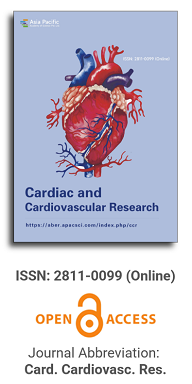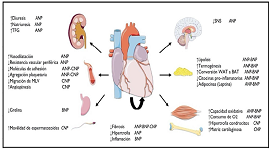
Asia Pacific Academy of Science Pte. Ltd. (APACSCI) specializes in international journal publishing. APACSCI adopts the open access publishing model and provides an important communication bridge for academic groups whose interest fields include engineering, technology, medicine, computer, mathematics, agriculture and forestry, and environment.

Time-Regular pattern analysis on effect of extreme temperature to the death of cerebrovascular and cardiovascular diseases in Chongqing
Vol 1, Issue 1, 2020
Download PDF
Abstract
Objective: To explore the relationship between extreme temperature and death from cardiovascular and cerebrovascular diseases in Chongqing, a “furnace city”, and its time regularity. Methods the death data of cardiovascular and cerebrovascular diseases, meteorological and environmental protection data from 2011 to 2013 in Chongqing were collected. The confounding factors such as air pollution, long-term and short-term trends were controlled. The distributed lag nonlinear model (dlnm) was used to analyze the lag effect and cumulative effect of extreme temperature on the death of cardiovascular and cerebrovascular diseases. Results for cerebrovascular disease death, the effect of high temperature was the greatest on the same day (rr= 166, 95% CI: 119–233) for 2 days; the influence of low temperature lags 4 days and lasts for 12 days. The maximum RR value appears on the 6th day (lag 6) and is 122 (95% CI: 106–141). For ischemic heart disease deaths, the effect of high temperature was greatest on the same day (rr= 188, 95% CI: 112–315) for 7 days; the influence of low temperature lags behind for 1 D and lasts for 27 D. The maximum RR value appears on the second day (lag 2) and is 205 (95% CI: 132–320). The cumulative risk of extreme high temperature (34 ℃) on death from cerebrovascular disease and ischemic heart disease was 208 (95% CI: 149–290) and 263 (95% CI: 127~542), and the cumulative effects of extreme low temperature (2 ℃) on them were 461 (95% CI: 185–115) and 120 (95% CI: 372–463). Conclusion the lag effect of extreme high temperature and low temperature on the death of the two diseases is different; the cumulative effect of extreme low temperature is higher than that of extreme high temperature, especially on the death of ischemic heart disease.
Keywords
References
- Intergovernmental Panel on Climate Change. Climate Change 2013: The Physical Science Basis. Cambridge University Press; 2013.
- Sharma HS, Westman J, Nyberg F, et al. Role of serotonin and prostaglandins in brain edema induced by heat stress: an experimental study in the young rat. Brain Edema IX. Acta Neurochirurgica, vol 60. Vienna: Springer; 1994. pp. 50–65.
- Hu SS, Kong LZ, Gao RL, et al. Outline of the report on cardiovascular disease in China, 2010. Biomed Environ Sci. 2012; 25(3): 251–156.
- Zhang XJ, Ma WP, Zhao NQ, et al. Time series analysis of the association between ambient temperature and cerebrovascular morbidity in the elderly in Shanghai, China. SciRep. 2016; 6: 19052.
- Fukuda T, Ohashi N, Doi K, et al. Impact of seasonal temperature environment on the neurologic prognosis of out-of-hospital cardiac arrest: a nationwide, population-based cohort study. J Crit Care. 2014; 29(5): 840–047.
- Guo YM, Li SS, Zhang YS, et al. Extremely cold and hot temperatures increase the risk of ischaemic heart disease mortality: epidemiological evidence from China. Heart. 2013; 99(3): 195–503.
- Tanaka H, Shinjo M, Tsukuma H, et al. Seasonal variation in mortality from ischemic heart disease and cerebrovascular disease in Okinawa and Osaka: the possible role of air temperature. J Epidemiol. 2000; 10(6): 392–298.
- Zhang YS, Li SS, Pan XC, et al. The effects of ambient temperature on cerebrovascular mortality: an epidemiologic study in four climatic zones in China. Environ Health. 2014; 13(1): 24.
- Yang CY, Meng X, Chen RJ, et al. Long-term variations in the association between ambient temperature and daily cardiovascular mortality in Shanghai, China. Sci Total Environ. 2015; 538: 524–430.
- Bunker A, Wildenhain J, Vandenbergh A, et al. Effects of air temperature on climate-sensitive mortality and morbidity outcomes in the elderly; a systematic review and meta-analysis of epidemiological evidence. EBioMed. 2016; 6: 258–868.
- Takumi I, Mishina M, Kominami S, et al. Ambient temperature change increases in stroke onset: analyses based on the Japanese regional metrological measurements. J Nippon Med Sch. 2015; 82(6): 281–186.
- Zheng DN, Arima H, Sato S, et al. Low ambient temperature and intracerebral hemorrhage: the INTERACT2 study. PLoS One. 2016; 11(2): e0149040.
- Hensel M, Stuhr M, Geppert D, et al. Relationship between ambient temperature and frequency and severity of cardiovascular emergencies: a prospective observational study based on out-of-hospital care data. Int J Cardiol. 2017; 228: 553–357.
- Wang QZ, Gao CL, Wang HC, et al. Ischemic stroke hospital admission associated with ambient temperature in Jinan, China. PLoS One. 2013; 8(11): e80381.
- Matsumoto M, Ishikawa S, Kajii E. Cumulative effects of weather on stroke incidence: a multi-community cohort study in Japan. J Epidemiol. 2010; 20(2): 136–642.
- Basagaña X, Sartini C, Barrera-Gómez J, et al. Heat waves and cause-specific mortality at all ages. Epidemiology. 2011; 22(6): 765–572.
- Turner LR, Barnett AG, Connell D, et al. Ambient temperature and cardiorespiratory morbidity: a systematic review and meta-analysis. Epidemiology. 2012; 23(4): 594–406.
- Vasconcelos J, Freire E, Almendra R, et al. The impact of winter cold weather on acute myocardial infarctions in Portugal. Environ Pollut. 2013; 183: 14–48.
- Grjibovski AM, Nurgaliyeva N, Kosbayeva A, et al. No association between temperature and deaths from cardiovascular and cerebrovascular diseases during the cold season in Astana, Kazakhstan -the second coldest capital in the world. Int J Circumpolar Health. 2012; 71(1): 19769.
- Gao HL, Lan L, Yang C, et al. The threshold temperature andlag effects on daily excess mortality in Harbin, China: a time se-ries analysis. Int J Occup Environ Med. 2017; 8(2): 85–55.
- Williams S, Nitschke M, Sullivan T, et al. Heat and health inAdelaide, South Australia: assessment of heat thresholds and temperature relationships. Sci Total Environ. 2012; 414: 126–633.
- Gasparrini A. Distributed lag linear and non-linear models: theRpackage dlnm. J Stat Softw. 2011; 43(8): 1–10.
- Wang XY, Li GX, Liu LQ, et al. Effects of extreme temperatures on cause-specific cardiovascular mortality in China. Int J EnvironRes Public Health. 2015; 12(12): 16136–16156.
- Ruan Y, Zhang L, Niu JP, et al. Effects of cold air activity onserum catecholamine level in patients with cardiovascular or cerebrovascular disease. HygieneRes. 2013; 42(4): 561–164.
- Sharma HS, Dey PK. Influence of long-term acute heat exposure on regional blood-brain barrier permeability, cerebral blood flow and 5-HT level in conscious normotensive young rats. BrainRes. 1987; 424(1): 153–362.
- Xi GH, KeepRF, Hoff JT. Mechanisms of brain injury after intracerebral haemorrhage. Lancet Neurol. 2006; 5: 53–33.
Supporting Agencies
Copyright (c) 2020 Yonghong Li, Shuquan Luo, Jinyu He, Yibin Cheng, Xiaoyuan Yao, Bo Sun, Yan Wang, Yinlong Jin

This work is licensed under a Creative Commons Attribution 4.0 International License.

This site is licensed under a Creative Commons Attribution 4.0 International License (CC BY 4.0).

Prof. Prakash Deedwania
University of California,
San Francisco, United States




